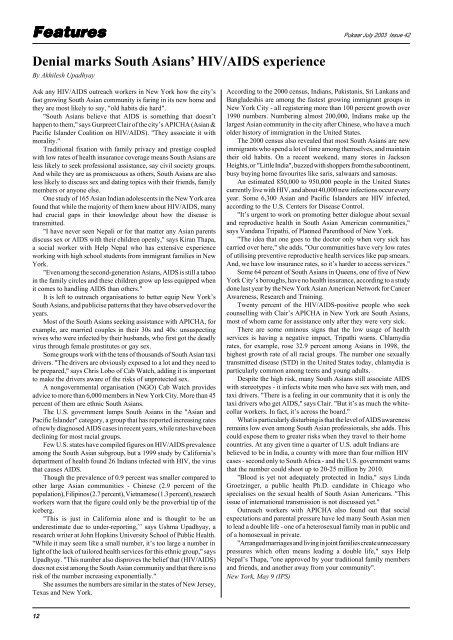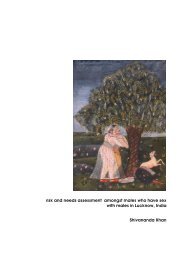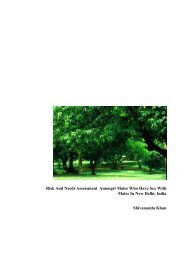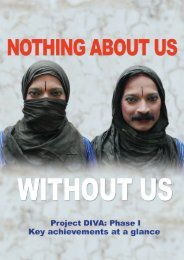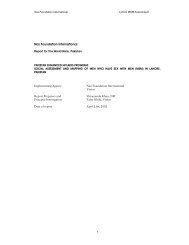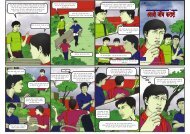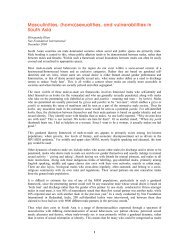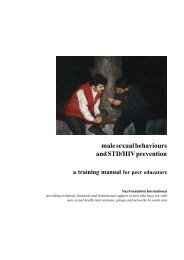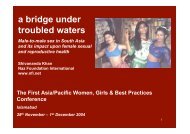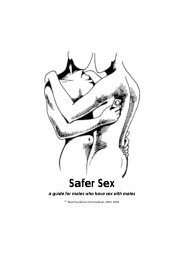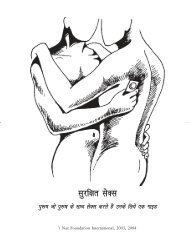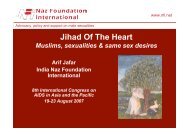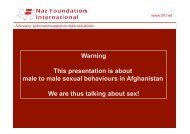Features - Naz Foundation International
Features - Naz Foundation International
Features - Naz Foundation International
Create successful ePaper yourself
Turn your PDF publications into a flip-book with our unique Google optimized e-Paper software.
<strong>Features</strong><br />
Pukaar July 2003 Issue 42<br />
Denial marks South Asians’ HIV/AIDS experience<br />
By Akhilesh Upadhyay<br />
Ask any HIV/AIDS outreach workers in New York how the city’s<br />
fast growing South Asian community is faring in its new home and<br />
they are most likely to say, "old habits die hard".<br />
"South Asians believe that AIDS is something that doesn’t<br />
happen to them," says Gurpreet Clair of the city’s APICHA (Asian &<br />
Pacific Islander Coalition on HIV/AIDS). "They associate it with<br />
morality."<br />
Traditional fixation with family privacy and prestige coupled<br />
with low rates of health insurance coverage means South Asians are<br />
less likely to seek professional assistance, say civil society groups.<br />
And while they are as promiscuous as others, South Asians are also<br />
less likely to discuss sex and dating topics with their friends, family<br />
members or anyone else.<br />
One study of 165 Asian Indian adolescents in the New York area<br />
found that while the majority of them knew about HIV/AIDS, many<br />
had crucial gaps in their knowledge about how the disease is<br />
transmitted.<br />
"I have never seen Nepali or for that matter any Asian parents<br />
discuss sex or AIDS with their children openly," says Kiran Thapa,<br />
a social worker with Help Nepal who has extensive experience<br />
working with high school students from immigrant families in New<br />
York.<br />
"Even among the second-generation Asians, AIDS is still a taboo<br />
in the family circles and these children grow up less equipped when<br />
it comes to handling AIDS than others."<br />
It is left to outreach organisations to better equip New York’s<br />
South Asians, and publicise patterns that they have observed over the<br />
years.<br />
Most of the South Asians seeking assistance with APICHA, for<br />
example, are married couples in their 30s and 40s: unsuspecting<br />
wives who were infected by their husbands, who first got the deadly<br />
virus through female prostitutes or gay sex.<br />
Some groups work with the tens of thousands of South Asian taxi<br />
drivers. "The drivers are obviously exposed to a lot and they need to<br />
be prepared," says Chris Lobo of Cab Watch, adding it is important<br />
to make the drivers aware of the risks of unprotected sex.<br />
A nongovernmental organisation (NGO) Cab Watch provides<br />
advice to more than 6,000 members in New York City. More than 45<br />
percent of them are ethnic South Asians.<br />
The U.S. government lumps South Asians in the "Asian and<br />
Pacific Islander" category, a group that has reported increasing rates<br />
of newly diagnosed AIDS cases in recent years, while rates have been<br />
declining for most racial groups.<br />
Few U.S. states have compiled figures on HIV/AIDS prevalence<br />
among the South Asian subgroup, but a 1999 study by California’s<br />
department of health found 26 Indians infected with HIV, the virus<br />
that causes AIDS.<br />
Though the prevalence of 0.9 percent was smaller compared to<br />
other large Asian communities - Chinese (2.9 percent of the<br />
population), Filipinos (2.7 percent), Vietnamese (1.3 percent), research<br />
workers warn that the figure could only be the proverbial tip of the<br />
iceberg.<br />
"This is just in California alone and is thought to be an<br />
underestimate due to under-reporting,’’ says Ushma Upadhyay, a<br />
research writer at John Hopkins University School of Public Health.<br />
"While it may seem like a small number, it’s too large a number in<br />
light of the lack of tailored health services for this ethnic group," says<br />
Upadhyay. "This number also disproves the belief that (HIV/AIDS)<br />
does not exist among the South Asian community and that there is no<br />
risk of the number increasing exponentially."<br />
She assumes the numbers are similar in the states of New Jersey,<br />
Texas and New York.<br />
According to the 2000 census, Indians, Pakistanis, Sri Lankans and<br />
Bangladeshis are among the fastest growing immigrant groups in<br />
New York City - all registering more than 100 percent growth over<br />
1990 numbers. Numbering almost 200,000, Indians make up the<br />
largest Asian community in the city after Chinese, who have a much<br />
older history of immigration in the United States.<br />
The 2000 census also revealed that most South Asians are new<br />
immigrants who spend a lot of time among themselves, and maintain<br />
their old habits. On a recent weekend, many stores in Jackson<br />
Heights, or "Little India", buzzed with shoppers from the subcontinent,<br />
busy buying home favourites like saris, salwaars and samosas.<br />
An estimated 850,000 to 950,000 people in the United States<br />
currently live with HIV, and about 40,000 new infections occur every<br />
year. Some 6,300 Asian and Pacific Islanders are HIV infected,<br />
according to the U.S. Centers for Disease Control.<br />
"It’s urgent to work on promoting better dialogue about sexual<br />
and reproductive health in South Asian American communities,"<br />
says Vandana Tripathi, of Planned Parenthood of New York.<br />
"The idea that one goes to the doctor only when very sick has<br />
carried over here," she adds. "Our communities have very low rates<br />
of utilising preventive reproductive health services like pap smears.<br />
And, we have low insurance rates, so it’s harder to access services."<br />
Some 64 percent of South Asians in Queens, one of five of New<br />
York City’s boroughs, have no health insurance, according to a study<br />
done last year by the New York Asian American Network for Cancer<br />
Awareness, Research and Training.<br />
Twenty percent of the HIV/AIDS-positive people who seek<br />
counselling with Clair’s APICHA in New York are South Asians,<br />
most of whom came for assistance only after they were very sick.<br />
There are some ominous signs that the low usage of health<br />
services is having a negative impact, Tripathi warns. Chlamydia<br />
rates, for example, rose 32.9 percent among Asians in 1998, the<br />
highest growth rate of all racial groups. The number one sexually<br />
transmitted disease (STD) in the United States today, chlamydia is<br />
particularly common among teens and young adults.<br />
Despite the high risk, many South Asians still associate AIDS<br />
with stereotypes - it infects white men who have sex with men, and<br />
taxi drivers. "There is a feeling in our community that it is only the<br />
taxi drivers who get AIDS," says Clair. "But it’s as much the whitecollar<br />
workers. In fact, it’s across the board."<br />
What is particularly disturbing is that the level of AIDS awareness<br />
remains low even among South Asian professionals, she adds. This<br />
could expose them to greater risks when they travel to their home<br />
countries. At any given time a quarter of U.S. adult Indians are<br />
believed to be in India, a country with more than four million HIV<br />
cases - second only to South Africa - and the U.S. government warns<br />
that the number could shoot up to 20-25 million by 2010.<br />
"Blood is yet not adequately protected in India," says Linda<br />
Groetzinger, a public health Ph.D. candidate in Chicago who<br />
specialises on the sexual health of South Asian Americans. "This<br />
issue of international transmission is not discussed yet."<br />
Outreach workers with APICHA also found out that social<br />
expectations and parental pressure have led many South Asian men<br />
to lead a double life - one of a heterosexual family man in public and<br />
of a homosexual in private.<br />
"Arranged marriages and living in joint families create unnecessary<br />
pressures which often means leading a double life," says Help<br />
Nepal’s Thapa, "one approved by your traditional family members<br />
and friends, and another away from your community".<br />
New York, May 9 (IPS)<br />
12


